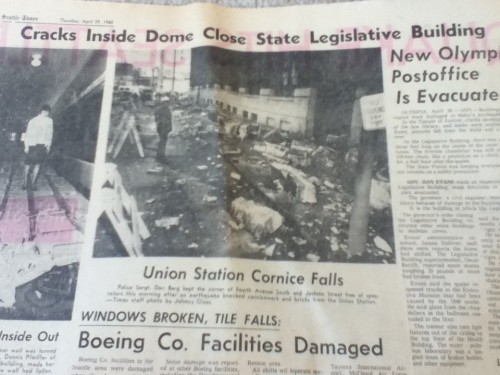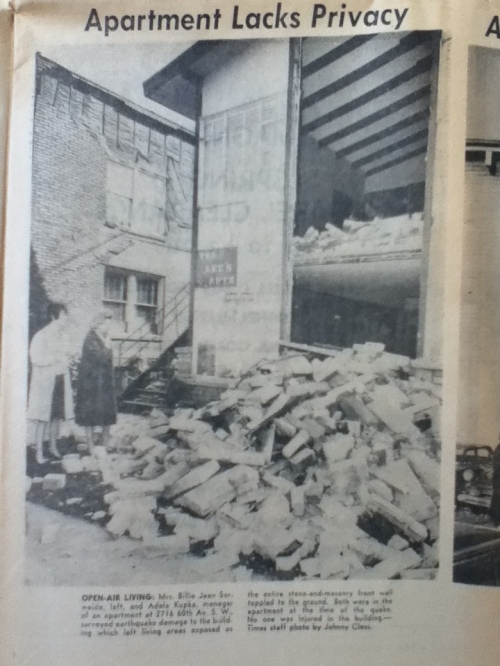This is the second of two posts on this blog that consist of asking Austin Elliott, who’s working on a Ph.D in geology at UC-Davis focused on seismology, a few questions about the nature of earthquakes in the Northwest and California and the general science of seismology. (Part one is Living With Earthquakes on the West Coast.) Austin also has a blog, The Trembling Earth, which is connected to his Ph.D work and looks at various topics in the earthquake field. In this post, Austin gives some details on the nature of seismology, new developments in the field (including early warning systems for earthquakes), and how being a seismologist changes his perspective on earthquake risks.
What are the biggest new or ongoing developments in seismology research since you started studying the subject? Is it analyzing the Tohoku quake?
We have had to radically shift existing paradigms about how earthquakes happen and how big they can be. Many of them come as a surprise to us because we’ve made insufficient assumptions about how individual faults interact, or how prior earthquakes on a single fault have changed the stress state to promote or inhibit subsequent earthquakes, as in the case of Tohoku. The earthquake rupture process is hugely complicated, and each quake is quite unique in its source process, relieving stress on one fault, loading stress onto another, jumping from one crack and continuing on another. Increasing volumes of seismograph data afford us increasingly detailed views of how an earthquake evolves, and they’re nothing like the simple breaks you learn about in your intro textbook.
I can’t list modern developments in seismology without mentioning Earthquake Early Warning. Systems that alert citizens of impending shaking are already operational in Japan and Mexico, and in the U.S. there has just been a huge push (read: influx of funding) to develop our own system. Conceptually this is as close as we can get to “predicting” earthquakes: knowing one is in progress and warning people who are far enough away and still have time to protect themselves. Our capabilities are there, but in practice we lag Japan and Mexico because we don’t have enough seismometers in the right places, and, ironically, we have barely enough earthquakes to run robust trials of the system. On top of that, we’ve built big dense cities directly on top of major fault lines, meaning in many places there would be no time for warning. There are still enough hypothetically damaging quakes that could happen far enough from population centers that the system is worthwhile, and you’ll be seeing and hearing much more about it in the coming years.
The other big thing that’s developing–seismologically speaking–is global social awareness of quake risk, and remarkable preventative/preparatory action. I think the internet is a huge driver of this awareness since more people than ever before are exposed to stories and imagery from earthquakes. In past centuries earthquakes were the things of distant legend, or rare occurrence, but now everyone the world over has witnessed their destruction. This is huge, because the primary problem with earthquake preparedness is how remote people consider their own risk.
How does seismology impact your day-to-day apprehension and awareness of earthquakes? Are you more or less nervous about them as a result of knowing more about how and how often they happen? For example, after Japan’s earthquake and the SE Asia Boxing Day earthquake in 2004, did you have a lot of foreboding about the destruction the following tsunamis would do?
I would say my understanding of seismology makes me immensely more attuned to the reality of earthquake risks than the average person. I think the biggest thing people fail to realize is the inevitability of earthquakes. Fault lines exist because the Earth’s crust has been jostling and grinding for hundreds of millions of years. The San Andreas Fault alone has accommodated the Pacific Plate sliding over 350 miles north past North America, and this of course will continue for the foreseeable geological future. If each big earthquake (a la 1906) stems from fault slip of 10-20 feet, this means the San Andreas has accommodated something like 150,000 earthquakes of that size in its history. That just floors me, and that doesn’t include damaging quakes that stem from subsidiary faults like the Hayward and the San Jacinto, or the myriad thrust faults terrorizing Los Angeles. Relatively to a human generational timescale, the error bars are large on when any given fault will slip to produce an earthquake, but the faults most certainly will slip, and we will most certainly have no warning*. The universal observation about earthquakes is that they always take a populace by surprise. You won’t know until it’s too late that it’s the day of The Big One, and they’ll most certainly happen in our future, just like they’ve happened to every generation in the past.
*Except for the ~10-20 seconds afforded by an early-warning system that’s triggered once a big quake starts.
My impression is that seismology, even more than most sciences, is a very data-hungry field. In the Northwest, the PNSN seems to have seismometers all over the place, including a lot of people’s homes. Is the basic goal in seismology to get as much data as you can about earthquakes and stresses that are building underground, and then find patterns in that data that tell you about how often, where, and why (maybe even when) earthquakes happen?
This question has hints of earthquake prediction, which I’m just gonna nip in the bud. One very minor component of seismology is detecting precursory signals, but decades of effort on that front have proved generally fruitless. There’s a fantastic review of the history of earthquake prediction in the book Predicting the Unpredictable by Susan Hough, if you’re interested in that.
You’re right though that seismology is a supremely data-hungry field. Seismology per se–the mathematical analysis of seismic signals–has two broad goals: understanding why earthquakes happen by painting detailed pictures of how they happen, and understanding what effects earthquakes may have through interaction of seismic waves with subterranean features, for example the hard bedrock edge of a sedimentary basin, which reflects seismic waves like the concrete wall of a pool does water. These goals are most often characterized as different approaches to the mathematical problem: to understand the earthquake source you have to piece together from multiple seismic recordings what the original pattern of seismic waves radiated from the fault was, making some assumptions about how they travelled to each station. To understand the effects of subterranean features you have to work out how those radiated waves were modified as they traveled from their source on the fault to your seismometer–or your house–making some assumptions about their original form.
Both of these approaches are immensely aided by more data. The Tohoku earthquake is a perfect example. Japan’s network of seismic measuring instruments (seismometers, accelerometers, GPS…) surpasses the quality and density of any other country’s, and so it captured a huge earthquake with more detail than ever in history. In the same way a musical performance sounds better if you mic all the instruments and not just one, an earthquake is far better represented with a huge suite of recording devices.
The other goals you mention–finding patterns that tell you how often and where earthquakes happen–are addressed by related fields that aren’t technically “seismology.” Geologic investigations of disrupted, deformed, and offset rocks constitute structural geology and can focus on a specific record of earthquakes that happened in the past–“paleoseismology.” Geodesy is measurement of the location and velocity of Earth’s surface, and is routinely conducted using GPS to assess the potential for earthquakes due to increasing strain around faults. One might claim that an ultimate goal of all of these fields (collectively, I’ll call them earthquake science) is to understand, model, and “predict” the occurrence of earthquakes from the evolving stresses that lead to them all the way to the detailed behavior of that patch of ground the new hospital sits on when it’s subjected to shaking from a nearby quake.





